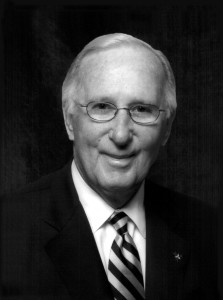LIVING WITH THE BOMB – Dick Hefton
Target weather reported CLEAR! The A/C (aircraft commander) of “Dimples 82” decides to gun it for the primary target and sets the auto-pilot on “Cruise Climb” to level at 31,000 feet, speed 328 MPH, for final vector to the target. The sun was rising that morning, August 6 as his bombardier climbed down in the bomb bay to remove all safety pins arming his load, a single bomb. On track, all systems GO, the bombardier releases “LITTLE BOY,” the world’s first of the only two atomic bombs used in warfare, and hopefully the only ever used again.
The A/C of the B-29 Superfortress, as you know, Paul Tibbets, had his crew adorned in flack suits and wearing heavy dark glasses in preparations for what they “knew not what to expect” from an unproven experiment hoped to bring Japan to surrender unconditionally saving up to a million allied lives.
While “Little Boy” was propelling toward Hiroshima and its military munitions factories, Tibbets disengaged the auto-pilot and hauled “Enola Gay” (named for his mother) into the steepest angle of turn and bank design features would sustain. While still in the escaping turn, a bright light filled the aircraft accompanied by “two very large slaps on the ship,” as described later by co-pilot Robert Lewis, “then that was all the psychical effects we felt.”
Tibbets related later, “We turned back to look at Hiroshima, the city was hidden by that awful cloud, mushrooming terribly and incredibly tall.” The crew was quiet and awed for a time then they all were letting their emotions fly. One crew member sounded what must have been on most of their minds, “Thank God the war is over and I don’t have to get shot at anymore, I can go home.” A feeling surely shared with some 500,000 U.S. troops on the high seas headed for an invasion of the Japanese homeland!
Only four months an unelected U.S. president, following the death of Franklin D. Roosevelt, Harry Truman, had ordered the atomic bomb delivery which would change war and humankind as never before or again. But likely save up to a million warriors in so doing.
Hiroshima alone, however, failed to bring an Imperial Japan to its knees. Three days later, acting on the terms of the first command, Major General Curtis LeMay’s command sent a second Superfortress carrying a larger (10,800 pounds) “Fat Man” to drop on Kokura which due to overcast skies diverted to Nagasaki. The next day Japan was in panic and accepted terms of unconditional surrender.
“The Bomb” assumed a life all its own under new and growing threats of MAD (mutual assured destruction) throughout the Cold War! School children learned to cope through “fallout” training while young adults made light of their fear with false bravado. Eventually, faces of the delivered 500,000 faded from view. One 18-year-old soldier, later to become my sister’s husband, was sailing for invasion of Japan with his 25th Infantry Division mates, following their long and bloody liberation of the Philippines.

